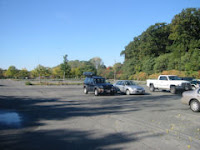 There is one very important benefit to building roads and parking spaces: They facilitate travel by automobile. Cars are a wonderful convenience. The personal mobility afforded by automobiles ranks so high in the list of fundamental human desires that people in developing countries around the world purchase cars as soon as they can afford them. Automobility is one of the great blessings of contemporary civilization.
There is one very important benefit to building roads and parking spaces: They facilitate travel by automobile. Cars are a wonderful convenience. The personal mobility afforded by automobiles ranks so high in the list of fundamental human desires that people in developing countries around the world purchase cars as soon as they can afford them. Automobility is one of the great blessings of contemporary civilization.
But there are hidden costs to building all that impervious surface, and Todd Litman with the Victoria Transport Policy Institute has cataloged most of them. Roads and parking add to the cost of land, public facilities and private housing stock. They create “suburban sprawl,” or disaggregated, low-density development, which leads to excessive gasoline consumption and carbon emissions. They increase waste water run off, add to water pollution, reduce open space and create urban heat-island effects. And the list goes on.
What especially gripes Litman in an article published in Environmental Practice, “Why and How to Reduce the Amount of Land Paved for Roads and Parking Facilities,” is that the excess supply of paved surface is the result of conscious government policy.
The optimal amount of roads and parking is the amount, Litman argues, that “could be financed if travelers had reasonable transport options … and paid all direct and indirect roadway costs [and parking costs] through user fees.” Mandating parking spaces reduces the incentive for employers to explore alternative solutions — arranging to use a nearby church’s parking lot during weekdays, for instance, or encouraging employees to ride share.
Most current planning policies are predicated upon the axiom that it is desirable to maximize road and parking supply. “Most communities have zoning codes that require generous minimum parking and roadway supply,” Litman writes. As a result of over supply, “many parking facilities are frequently under-used.”
Litman enumerates several strategies that would enable communities to reduce the acreage of impervious surface. He covers the gamut from better streetscaping to setting prices for paid parking, from parking taxes to improved facility design. They are all ideas worthy of consideration.
What Litman inexplicably does not list is a recommendation for getting local governments out of the business of mandating parking requirements in the first place. Wal-Mart executives know how many parking spaces to place around their stores — they don’t need local zoning boards telling them their business. Let office-park tenants trade off the cost of “free” parking (which isn’t free, but bundled into the price of their rent) with the cost of implementing a Transportation Demand Management Plan. Let market prices allocate scarce parking and transport assets. Unleash human creativity.
Litman contends that the space set aside for impervious space can be reduced by 20% to 40% by applying cost-effective transport and parking-management strategies. In turn, shrinking asphalt acreage by that amount would allow offices, stores and houses to be located closer together, making more destinations accessible by foot, bike or mass transit. Always remember: “Sprawl” is not the result of untrammeled markets and insufficient planning. It is the result of too much and the wrong kind of planning.


